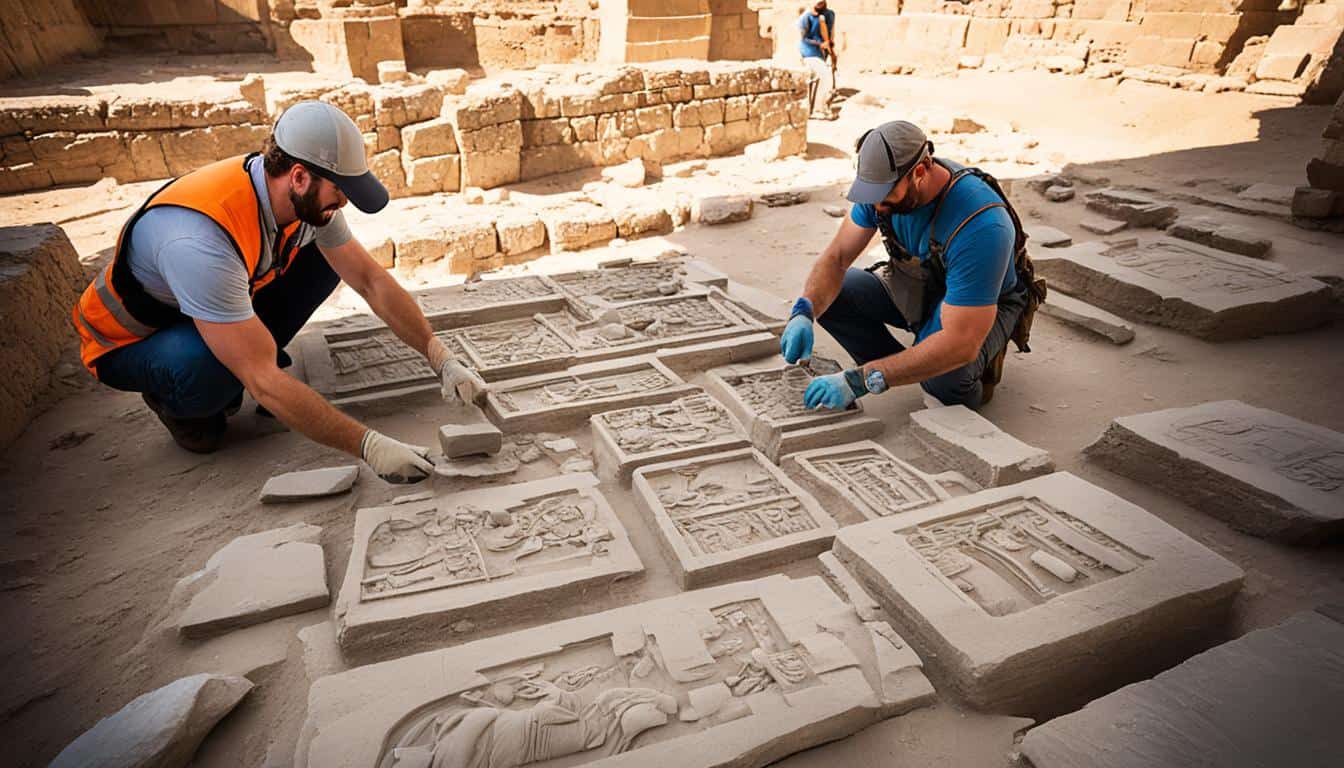Table of Contents
Ever thought about the secrets beneath Jerusalem’s ancient stones?
Like the Western Wall, the Pool of Bethesda, and more. What stories are they hiding?
We’re about to explore archeology and biblical tales tied to Zion’s Stones. This journey will uncover their deep spiritual significance. And how they connect to the Messiah, challenging what we often believe.
The Foundation Stone: A Link to Creation and Christ
The Foundation Stone is under the Dome of the Rock. It is very important in the Bible and in archaeology. It shows our faith and how we connect to creation and Christ.
In Ephesians 2:20, Paul talks about Jesus being the most important cornerstone. “built upon the foundation of the apostles and prophets, Jesus Christ Himself being the chief cornerstone.” This shows how Jesus is central to our beliefs. The Foundation Stone under the Temple Mount is like Jesus. It shows how he is at the center of our faith.
Like a cornerstone supports a building, the Foundation Stone gives strength. It shows Jesus is the strong base of our faith.
The Foundation Stone also links to the story of creation. The Bible often talks about creation’s foundation. The Foundation Stone shows God’s rule and how he made everything. It helps us understand creation better.
The Foundation Stone brings historical and spiritual stories together. It reminds us of our faith’s roots and shows how important Jesus is. He is key to our salvation.
Significance of the Foundation Stone
| Symbol | Meaning |
|---|---|
| Cornerstone | Jesus as the foundational strength of faith |
| Creation | Symbolic tie to divine creation and authority |
| Unity | Connects the historical and spiritual journey of humanity |
The Western Wall: Lasting Legacy and Divine Presence
When you stand before the Western Wall’s ancient stones, a sense of humility washes over you. These stones are not only relics of the past. They bear witness to a divine presence that echoes in this sacred place. The Western Wall, or Wailing Wall, is deeply cherished by people worldwide.
The wall’s survival reveals its deep spiritual importance. It acts as a bridge to history, linking us with Jerusalem’s past and Jesus’ prophecies. In Matthew 24:1-2, Jesus predicted the temple’s fall, saying no stone would remain. Yet, the Western Wall stands, a resilient symbol of faith.
The divine feeling here transcends mere bricks. Prayers fill the air as people reach out to the divine at this wall. It serves as a meeting point between heaven and earth. Here, we feel Christ’s eternal love and the dedication of his believers.
History’s prayers echo against the wall, each one enriching its legacy. These stones carry countless dreams and desires, uniting people with the divine. This place seems to blur the lines between heaven and earth. It draws believers closer to God’s presence.
Approaching the Western Wall, ponder its profound legacy and the divine connection it symbolizes. Let its ancient stones remind you of Christ’s everlasting nature and faith’s enduring strength.
Despite challenges and time’s passage, the Western Wall remains firm. It’s a powerful symbol of humanity’s bond with the divine.
| Key Points |
|---|
| The Western Wall is a lasting legacy that defies the passage of time. |
| Jesus predicted the destruction of the temple, yet the Western Wall remains standing. |
| The Western Wall serves as a sacred space connecting believers with the eternal nature of Christ. |
| Countless prayers and supplications have been offered at the Western Wall throughout history. |
| The divine presence at the Western Wall is a testament to the enduring power of faith. |
The Pool of Bethesda: Healing Waters and the Healer Messiah
The Pool of Bethesda is a significant site in Jesus’ ministry in Jerusalem. It’s featured in the Gospel of John (5:1-9). This place shows Jesus’ compassion and his divine power.
The Pool, close to the Sheep Gate in Jerusalem, was famous for its healing powers. People believed an angel would stir its waters. The first one in after this would get healed. This made the Pool a beacon of hope for many.
Jesus’ healing at the Pool of Bethesda mirrors his wider ministry. He healed many, showing authority and compassion. People sought out Jesus just like they sought healing at the Pool.
“Rise, take up thy bed, and walk,” said Jesus to a long-suffering man at the Pool (John 5:8). This man was healed instantly, showing Jesus’ power and his role as the Healer Messiah.
Archaeological digs in the 19th century found the Pool of Bethesda. They uncovered a structure with five porticoes, just as described in the Bible. This discovery is solid proof of the Pool’s place in history and its biblical ties.
The healing story at the Pool of Bethesda is deeply meaningful. It’s about more than just physical healing. It’s about Jesus’ power to heal our inner brokenness. His actions at Bethesda show us he can make our lives whole again.
The Pool of Bethesda: A Comparison of Healing
To understand the Pool of Bethesda and Jesus’ ministry better, let’s compare:
| Pool of Bethesda | Jesus’ Healing Ministry |
|---|---|
| Physical healing | Physical and spiritual healing |
| Belief in the stirring of the waters | Belief in Jesus’ miraculous power |
| Single site for healing | Healing witnessed throughout Jerusalem |
These comparisons help us see how Jesus, as the Healer Messiah, deeply impacted Jerusalem.

The image shows the Pool of Bethesda during Jesus’ time. It helps us visualize where Jesus performed miracles. It underscores how the location is linked to Jesus’ healing actions.
Mount Zion: David’s City and the King of Kings
Exploring Jesus’ journey to Jerusalem reveals Mount Zion’s role in history and prophecy. It is where David’s City stood, linking royal lineage with God’s plan according to the Bible.
Mount Zion is sacred in Jewish and Christian traditions. King David made it his capital and brought the Ark of the Covenant there. It was considered the dwelling place of God’s presence.
“For the LORD hath chosen Zion; he hath desired it for his habitation.” – Psalm 132:13
The Kings of Judah ruled from Mount Zion, waiting for the Messiah. These prophecies told of a King who would bring everlasting peace and salvation.
Jesus’ entry into Jerusalem on Palm Sunday fulfilled these prophecies. The people welcomed Him as the King of Kings, seeing Him as the Messiah. This event highlighted the significance of David’s City in divine history.
Hebrews 12:22 highlights Mount Zion’s eternal significance. It connects to the heavenly Jerusalem, where angels and believers gather joyfully. This shows Mount Zion’s role beyond history as a symbol of our heavenly home with Christ.
| Significance of Mount Zion | Related Scriptures |
|---|---|
| Zion as the dwelling place of God | Psalm 132:13 |
| Mount Zion as the center of David’s reign | 2 Samuel 5:7 |
| Mount Zion as the arrival point of the Messiah | Mark 11:1-11 |
| Mount Zion as a heavenly city | Hebrews 12:22 |
Mount Zion symbolizes the realization of God’s promises and Christ’s eternal reign. It reminds us that our faith reaches beyond this world to the heavenly Jerusalem, under the rule of the King of Kings.
The Via Dolorosa: Tracing Christ’s Footsteps in Stone
Walking the Via Dolorosa is a sacred journey. It lets you trace the steps of Jesus and connect with His sacrifice. This historic path goes through Jerusalem’s old city, with each step marking a significant moment on Christ’s way to the cross.
The Via Dolorosa means the “Way of Suffering.” It’s special for Christians globally. It’s believed to be Jesus’ path, carrying His cross, to His crucifixion. Walking this path, you feel Jesus’ love and the sacrifice He made for humanity.
This path is not just a spiritual connection but also holds archaeological significance. The stony paths share historical and cultural stories, offering a peek into ancient times and Jesus’ era.
The stones of the Via Dolorosa link us to history. These stones have seen many pilgrims retrace Christ’s steps, leaving a lasting impact. It’s inspiring to walk where Jesus did, feeling His sacrifice with every step.
“Blessed be the Lord God of Israel; for he hath visited and redeemed his people.”
Luke 1:68
Walking the Via Dolorosa makes you think about Jesus’ love and His great sacrifice. Each station is a unique moment in Christ’s Passion. They let you stop, pray, and reflect on His act of redemption.
| Station | Description |
|---|---|
| 1 | Jesus is condemned to death |
| 2 | Jesus carries His cross |
| 3 | Jesus falls the first time |
| 4 | Jesus meets His mother, Mary |
| 5 | Simon of Cyrene helps Jesus carry the cross |
| 6 | Veronica wipes the face of Jesus |
| 7 | Jesus falls the second time |
| 8 | Jesus meets the women of Jerusalem |
| 9 | Jesus falls the third time |
| 10 | Jesus is stripped of His garments |
| 11 | Jesus is nailed to the cross |
| 12 | Jesus dies on the cross |
| 13 | Jesus is taken down from the cross |
| 14 | Jesus is laid in the tomb |
Each station of the Via Dolorosa makes you think of Jesus’ deep suffering and love. It’s a journey that ties you to the Gospel’s core and strengthens your faith.
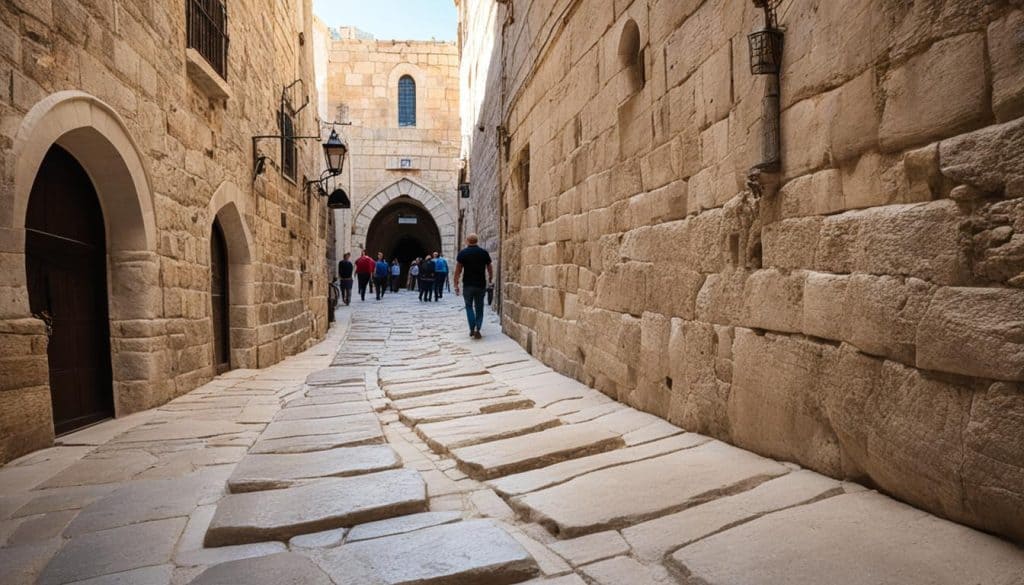
The Garden Tomb: A Sacred Space of Resurrection
The Garden Tomb symbolizes Christ’s resurrection and his power to give life. Located in Jerusalem, this sacred site reminds us of the hope and everlasting life that our Savior offers.
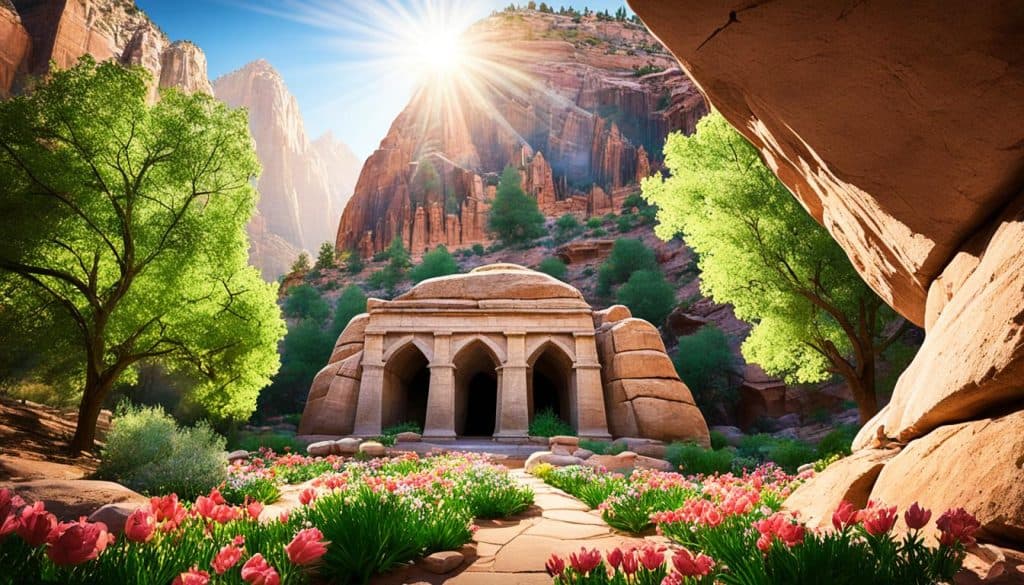
Many believe this serene place is where Jesus was buried and resurrected. Its calm setting and green surroundings make it a perfect place for prayer. Standing here fills us with awe and deep respect.
The Garden Tomb matches the Bible’s description of Jesus’ burial and resurrection. It has a layout and an entrance stone that suggest the tomb was empty. This supports the accounts of Christ’s resurrection. It’s where we see life defeating death, fulfilling God’s promise, and keeping our faith alive.
“He is not here: for he is risen, as he said. Come, see the place where the Lord lay.” – Matthew 28:6 (KJV)
The Significance of Resurrection
This Tomb visually reminds us of Christ’s victory over death. It’s a key part of Christian faith, showing our Savior’s life-giving power.
Thinking about the Garden Tomb, we’re amazed by Christ’s sacrifice. It offers us hope, new life, and the chance for redemption. This is all possible through believing in Jesus.
A Place of Pilgrimage and Reflection
Visitors from everywhere come to the Garden Tomb for peace and spiritual connection. It shows the lasting impact of Jesus and encourages us to deepen our faith.
As we walk here, we imagine the disciples’ surprise and happiness finding the tomb empty. This place helps us feel connected to the love and sacrifice of our Lord.
“Jesus said unto her, I am the resurrection, and the life: he that believeth in me, though he were dead, yet shall he live.”
Continuing Relevance and Inspiration
The Garden Tomb still inspires and strengthens believers’ faith today. It shows Christ’s resurrection’s power and the hope it brings to those who accept it.
Visiting this place connects us with our faith’s ancient origins. It allows us to experience the powerful love of Jesus Christ. It reminds us of the eternal life promised to us through faith.
| Key Takeaways |
|---|
| ● The Garden Tomb symbolizes the resurrection and life-giving power of Christ |
| ● The tomb aligns with biblical descriptions of Jesus’ burial and resurrection |
| ● It serves as a place of pilgrimage and reflection for believers worldwide |
| ● The Garden Tomb inspires faith in the transformative power of Christ’s resurrection |
The Pool of Siloam: A Testament to Jesus’ Miracles
The Pool of Siloam is very important because it shows the miracles Jesus did in Jerusalem. The finding of this pool supports stories in the Bible about Jesus’ healing powers.
In the Bible, Jesus heals a man who was blind from birth near this pool. He mixed his saliva with dirt, put it on the man’s eyes, and told him to wash in the Pool of Siloam. After washing, the man could see. This was a big change for him.
“…Go, wash in the pool of Siloam… So he went and washed, and came seeing.” – John 9:7
The Pool of Siloam was in the south part of Jerusalem. It gave water to the city’s people. A tunnel, called Hezekiah’s Tunnel, brought water from a spring to the pool. This showed God’s care for the people.
The Significance of Jesus Choosing the Pool of Siloam
Jesus chose the Pool of Siloam for a miracle on purpose. It showed his power and connected to old prophecies.
Water is a symbol of cleaning. This miracle at the Pool of Siloam shows Jesus can clean us from sin. It hints at greater healing through believing in him.
The Pool of Siloam reminds us of Jesus’ kindness to people who are ignored or in need. His miracle there shows he wants to heal and restore everyone who trusts in him.
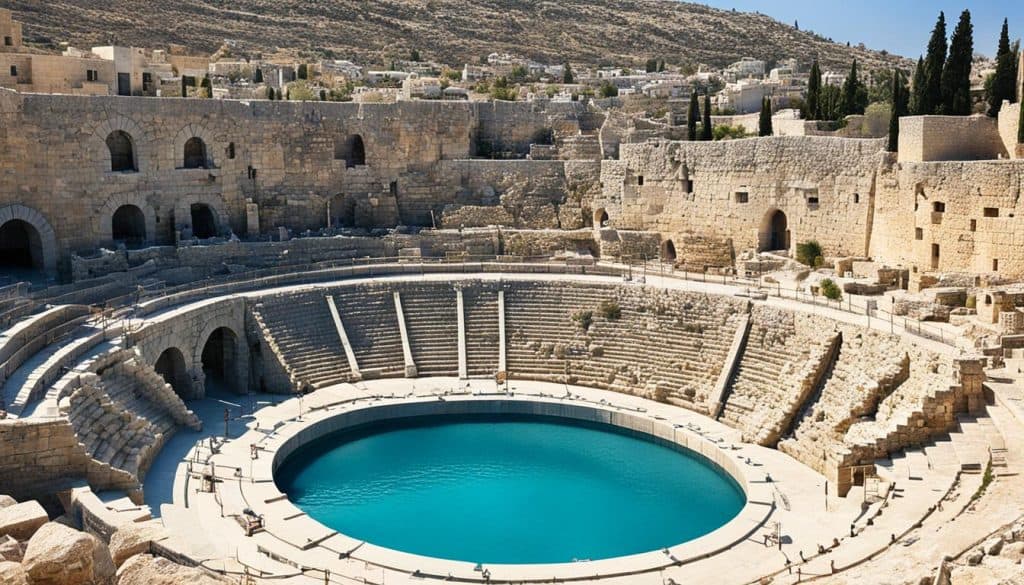
Looking into the Pool of Siloam’s archaeology and biblical stories helps us understand Jesus better. This place proves how Jesus’ love changed things in amazing ways when he was in Jerusalem.
The Steps to the Temple: A Pathway to Prophecy
As you climb the steps to the Temple Mount in Jerusalem, you follow a path many pilgrims have taken. You’re not just walking; you’re moving closer to understanding ancient prophecy and revelation. These steps, shaped by centuries of devotion, are full of history. They echo Jesus’ teachings and his challenges to the leaders of his time.
Every step taken here brings Jesus’ words to life. He shared the mysteries of the Kingdom of God on these very steps. He declared himself the Messiah, clearly and boldly. Climbing these steps symbolizes your own spiritual journey. It reflects moving towards a deeper understanding and seeing ancient prophecies come true.
In Matthew 21:12-13, Jesus made a bold move on the Temple Mount. He challenged the practices of money changers and those buying and selling in this holy place. His actions showed his authority and his desire for worship to be pure. He stood up to religious leaders who had forgotten the purpose of worship.
Jesus’ teachings help us understand old prophecies. From the Mount of Olives, opposite the Temple, he predicted its destruction (Matthew 24). He connected these predictions to the temple, highlighting the times’ urgency and the need for spiritual insight.
“And Jesus went out, and departed from the temple: and his disciples came to him for to shew him the buildings of the temple. And Jesus said unto them, See ye not all these things? verily I say unto you, There shall not be left here one stone upon another, that shall not be thrown down.” – Matthew 24:1-2
Walking these old steps, think about prophecy and its role today. Jesus fulfilled ancient predictions. Like him, we should seek to see God’s promises take shape in our lives.
| Steps to the Temple | Prophecy |
|---|---|
| The physical path followed by countless pilgrims | Symbolic of the journey towards greater spiritual understanding |
| Jesus’ teachings challenge religious authorities | Brings to life ancient prophecies |
| Connection to the urgency of the times | Opportunity for spiritual discernment |
| Reflection on the fulfillment of God’s promises | Invitation to seek fulfillment in your own life |
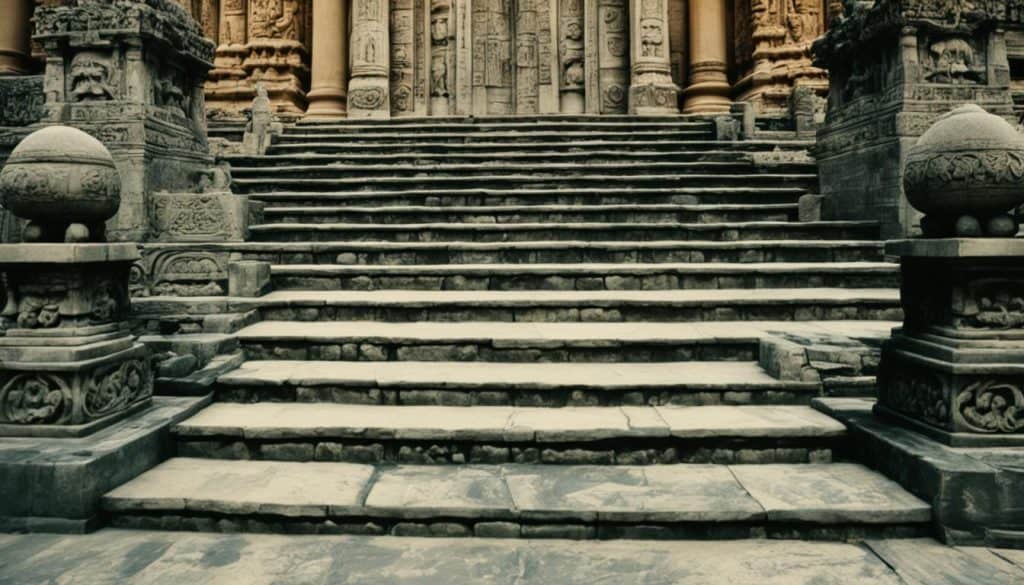
Standing on the temple steps, let prophecy and Jesus’ teachings touch your heart. Let this sacred journey remind you of timeless truths. May it guide your faith and inspire you to live with purpose and devotion.
The City of David: Uncovering the Roots of the Messiah
We now explore significant sites in Jerusalem, focusing on the City of David. This ancient area holds immense historical and spiritual importance. It gives us insights into the Messiah’s roots.
Researchers have found remains and artifacts through digs in the City of David. These finds help us grasp the Bible’s narrative and Jesus’ lineage.
The Pool of Siloam is a major discovery, mentioned in the Gospel of John. Supplied by the Gihon Spring, this large pool was a key spot for locals. It’s where Jesus healed a blind man, making it more significant.
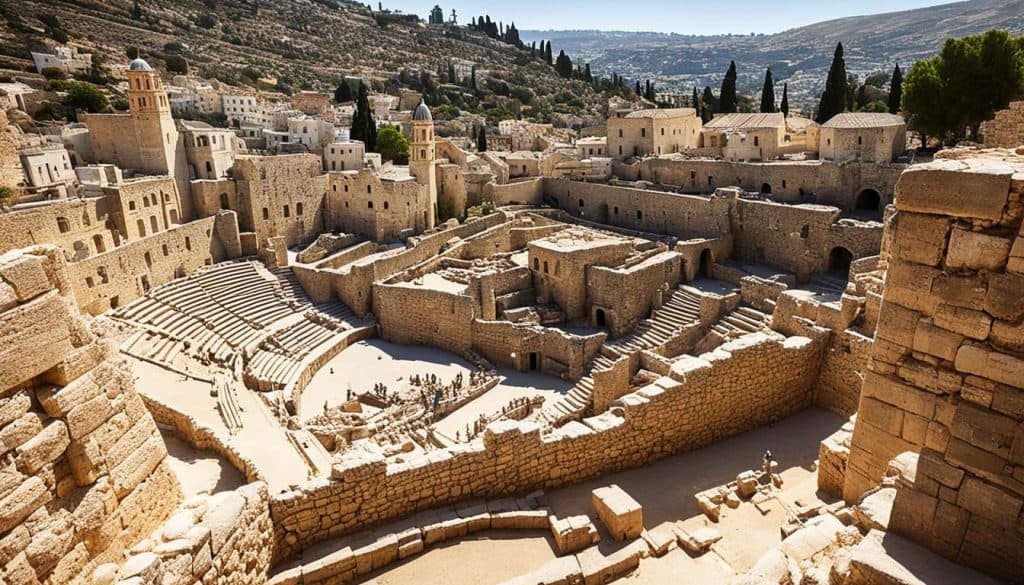
The City of David is linked to King David, who made Jerusalem his capital. David’s palace, as the Bible says, was in this ancient city. Visiting David’s palace ruins connects us with the Messiah’s roots.
The prophecy in Jeremiah 23:5 about David’s descendant is fulfilled in Jesus. Exploring the City of David helps us understand Jesus’ royal background. It shows how Old Testament prophecies were realized.
Exploring the City of David: A Journey through History
Walking through the City of David immerses you in Jerusalem’s vast history. You’ll see ruins of David’s palace and ancient tunnels like Hezekiah’s Tunnel. Each step shows the journey of faith linked to the Messiah.
Strolling the City of David’s narrow streets, you feel the past’s presence. This place echoes Bible stories. It highlights the deep tie between Jerusalem’s history and spirituality.
The City of David shows the Messiah’s spiritual roots. Faith and history merge here, enhancing our biblical narrative appreciation. It deepens our respect for Jesus’ life and ministry.
Key Discoveries in the City of David
| Site | Significance |
|---|---|
| Pool of Siloam | Jesus’ miracle of healing a blind man |
| David’s Palace | Connection to the royal lineage of the Messiah |
| Hezekiah’s Tunnel | An engineering marvel from biblical times |
| Warren’s Shaft | Water source during ancient times |
These examples highlight the City of David’s significant finds. Every dig and artifact brings us closer to understanding the Messiah’s roots. They show Jesus’ deep bond with Jerusalem.
Next, we’ll see Gethsemane’s Olive Trees. They tell us about Jesus’ prayers and betrayal. This adds to our knowledge of the Messiah’s journey.
Gethsemane’s Olive Trees: Witnesses to Prayer and Betrayal
In Jerusalem’s Gethsemane, ancient olive trees stand tall. They have witnessed profound moments. Jesus prayed and was betrayed among them. These trees are crucial to the Holy Land’s history and spirituality.
Gethsemane lies at the Mount of Olives’ foot. It was Jesus’ retreat for solitude and connection with God. Here, with his disciples, he sought strength and guidance before his crucifixion.
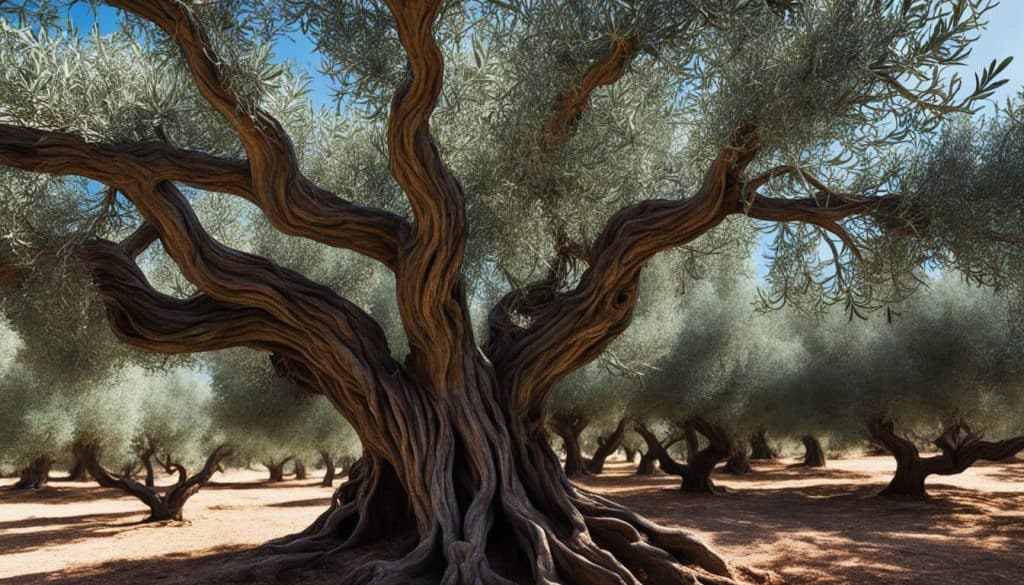
The olive trees saw Jesus’ deep prayers. He asked for God’s will, showing his commitment to his mission. These trees remind us of his devotion and sacrifice.
Judas Iscariot’s betrayal also unfolded here. Jesus was arrested in this peaceful garden. This marked his path to crucifixion. The silent olive trees witnessed it all, from betrayal to sacrifice for us.
“Father, if thou be willing, remove this cup from me: nevertheless not my will, but thine, be done.” – Luke 22:42 (KJV)
The Symbolism of Prayer and Betrayal
Gethsemane’s olive trees symbolize prayer’s sanctity. They show the strength found in connecting with God. Like olive oil symbolizes peace, Jesus found strength in this connection.
Their presence during Jesus’ betrayal shows human weakness. It reminds us of our need for forgiveness and redemption.
The olive trees teach us about prayer’s power, betrayal’s cost, and Jesus’ sacrifice. They stand for hope, forgiveness, and new life through Jesus’ resurrection.
Gethsemane’s Olive Trees: A Call to Reflection and Renewal
As we think about Gethsemane’s olive trees, let’s reflect on our lives. Their silence encourages us to find comfort in prayer and divine connection.
They also urge us to face our betrayal tendencies. Just as Jesus’ sacrifice offers hope, we can find renewal and forgiveness.
Let’s learn from Gethsemane’s olive trees. We’re inspired to connect deeply with God, live rightly, and forgive others. May these trees guide us toward grace and renewal.
| Significance | Symbolism |
|---|---|
| Witnessing Jesus’ prayer | The profound connection between prayer and seeking God’s will |
| Witnessing Jesus’ betrayal | The painful reality of human weakness and the need for redemption |
| Presence in Gethsemane | Inspiration for embracing prayer and examining our own capacity for betrayal |
What evidence of ancient worship and religious practices has been found in Zion?
Archaeological excavations in Zion have uncovered fascinating evidence of ancient worship and religious practices. The discovery of ritual objects, inscriptions, and architectural remains all point to the presence of zion temple worship in Bible times. These findings shed light on the spiritual beliefs and customs of the ancient inhabitants of Zion.
Conclusion
Congratulations! You’ve started an amazing journey through archeology and the Bible in Jerusalem. Each site, from the foundational stone to the Garden Tomb, shows the deep history and spiritual meaning of Zion’s Stones.
Through archeology and the Bible, we’ve seen how sacred places help us understand Jesus Christ and his mission.
The foundation stone under the Dome of the Rock connects creation to Christ. It shows Jesus as our faith’s cornerstone. The Western Wall shows God’s presence and Christ’s eternity.
The pools of Bethesda and Siloam prove Jesus’ healing miracles, giving hope and redemption to believers.
Following Christ’s path on the Via Dolorosa and thinking about Mount Zion and the City of David shows God’s plan through Jesus. The olive trees in Gethsemane remind us of Jesus’ prayers and the betrayal that led to his death.
These sites and their archeology help us better understand Jesus’ life, teachings, and sacrifice. They link faith and history, inviting us to follow Jesus’ steps and get closer to God. May your exploration of Zion’s Stones continue to enrich and deepen your faith.

